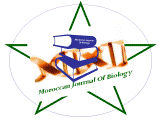Abstract
Urinary tract infection (UTI) is one among the foremost prevalent diseases affecting people of
both genders and all age groups. The management of UTI relies on the likely etiology of UTI
and knowledge of their antimicrobial susceptibility patterns. Extensive application of
antibiotics has led to the emergence of resistant microorganisms. This study was conducted to
research the prevalence rate of UTI among patients of different age groups and to analyze the
recent antibiotic susceptibility pattern of uropathogen in UTI because the antibiogram of the
microorganisms is repeatedly changing. In a prospective study undertaken at Al-Hera General
Hospital, Sadar, Sirajganj over a 9 month period, 159 samples from patients suspected of
having UTI were analyzed, of which 57 were culture positive. Identification of the isolated
bacteria was performed by standard tests, and antibiotic susceptibility was measured by disc
diffusion method. The total predominance of UTI was 35.8% of which 78.9% were females
and 21.1% were from males. Greater prevalence was detected in females as compared to
males. The overall prevalence in females was high in the age range of 21-60 yr (57.8%),
followed by 1-20 yr (22.2%) and > 60 yr (20%). In males the frequency is high in 21-40 yr
(41.7%); both the age range of 41-60 yr and > 60 yr was 50%, and the rest of 8.3% for the age
group of 1-20 yr. From the total 57 uropathogens, E. coli was estimated for 63.1% of all the
isolate, followed by Pseudomonas spp. (7%), Proteus spp. (5.2%), Klebsiella pneumoniae
(5.2%), Staphylococcus saprophyticus (5.2%), Salmonella spp. (3.5%), Serratia spp. (3.5%),
Citrobacter frundii (5.2%), and Candida albicans (1.8%). In the present study, the most
potent antibiotics were Amikacin, Imipenem, Nitrofurantoin, Meropenem, and Amoxiclav,
while on the contrary higher resistance was observed among the commonly used drugs like
Cephradine, Amoxicillin, Cotrimoxazole, and Ceftazidime. UTI may be a serious health
problem if untreated. Initial diagnosis and immediate treatment will prevent the probabilities
of developing further complication of UTI. Both the patient's age and gender can increase
accuracy in defining the causative agents and providing a useful guideline to treat UTI. As the
drug resistance pattern of the bacterial pathogens of UTI is greatly varied with time, regular
surveillance and monitoring are vital for giving updated information to the physician for
effective management of UTI.
 Moroccan Journal Of Biology. ISSN : 1114-8756
Moroccan Journal Of Biology. ISSN : 1114-8756